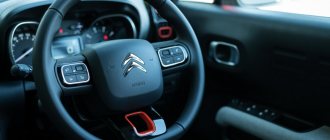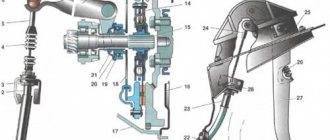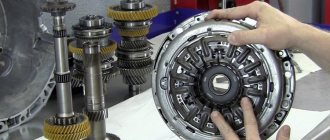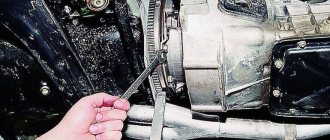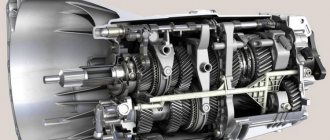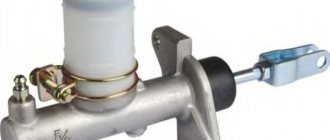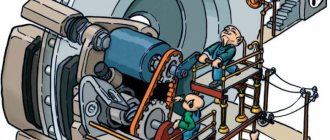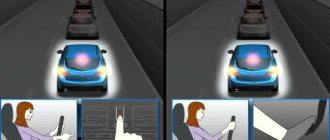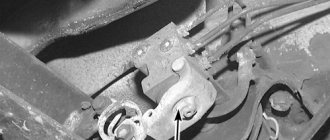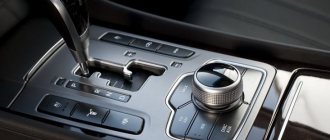The clutch is a mechanism designed to transmit engine torque to the gearbox, as well as smoothly connect and disconnect the engine with the transmission mechanisms. With its help, you can start driving a car, change gears, stop with the engine running, and maneuver during sudden changes in speed.
The clutch mechanism protects the vehicle's engine and transmission parts from damage and overload during rapid gear changes and sudden braking.
At the end of this article, watch the video tutorial , which very clearly demonstrates how the clutch mechanism in a car works.
And below we will talk about the principle of operation of the car clutch, the design and types of drives for engaging and disengaging the clutch, and how to properly use the clutch mechanism on cars with a manual transmission.
Car clutch device
The operation of the car’s clutch is ensured by the following parts:
- flywheel;
- fork;
- pressure disk;
- spring (can be push or pull type);
- release bearing and clutch;
- driven disk;
- drive elements.
The flywheel is responsible for transmitting torque to the gearbox. It is mounted on the crankshaft of the engine. The pressure plate, or as it is also called the “basket,” is an element rigidly fixed on the flywheel, to which the springs of the driven disk are attached.
The pressure and driven disks in connection with the flywheel are responsible for the smooth distribution of torque from the engine to the manual transmission. The parts are in close contact with each other or move away from each other, depending on the pedal press inside the car.
The push clutch performs the main function: it smoothly disconnects during braking and connects the engine and gearbox when starting. At the same time, it compensates for the load and minimizes the vibration impact from the engine, thereby partially unloading the elements of the engine, vehicle transmission and clutch unit.
The release bearing protects the clutch from wear. When you press the pedal, the fork separates the pressure and driven discs. The remaining components of the clutch drive are cables, hydraulic cylinders, tubes and the pedal itself.
conclusions
So, in this article we introduced you to the principle of operation of the clutch and explained what functions it performs in the design of the car. Like any part, the clutch tends to wear out. It is impossible to determine the exact shelf life of this mechanism, since it directly depends on the dexterity and accuracy of the driver. Grip also suffers from uneven road surfaces with deep holes and from traffic jams, since the driver often has to slow down, or even brake completely, and then move off again. Therefore, if you hear an unpleasant smell in the cabin, there is a reason to stop by the service station and have a technical inspection.
What happens when you press the pedal
It is physically impossible to change speed with constant engine pressure on the gearbox. The clutch was invented in order to smooth out vibrations. It absorbs impacts during the transition from gear to gear, protecting the car from overloads.
The switching process is as follows:
- the driver from inside the car presses the clutch pedal with his left foot;
- the fork moves the release bearing;
- the release bearing secures the blades of the diaphragm spring;
- the compressed spring stops pressing on the pressure plate;
- the engine is disconnected from the transmission;
- the driver releases the clutch pedal;
- the fork does not affect the release bearing and spring;
- the pressure plate presses the driven disk against the flywheel;
- The transmission is reconnected to the engine.
Is it difficult to drive a manual car?
Novice drivers are sure that learning to drive with a manual transmission is almost impossible. In fact, this is a myth, because there was a time when automation had not yet been invented. However, this did not stop anyone from driving. Learning to drive with a manual transmission is considered the most difficult compared to other types of transmission. Having acquired the skill of driving a manual, it is easier to adapt to other gearboxes.
Mechanics is a type of transmission where gear shifting is done manually. The driver switches gears while driving, according to the prevailing conditions and planned actions. In this case, you need to drive while concentrating on driving the vehicle, which makes the driver focused on the control process and more attentive on the roads.
Mechanics allow you to quickly accelerate and brake, allowing you to drive “feeling” the car and controlling its movement. An experienced instructor is a quick way to learn how to drive with mechanics; it is important to listen carefully to his advice and remember the recommendations.
How to understand that the clutch is breaking
There are “bad habits” that lead to rapid wear of the car’s mechanical clutch. You should try to avoid them in order to prolong the life of the parts. Will lead to a quick repair:
- Intensive pressing of the gas pedal when starting the car. The higher the engine speed when the clutch is depressed, the more the discs wear out.
- Keeping the clutch pedal depressed during short stops, for example, at a traffic light. Excessive pressure exhausts the life of the release bearing and pressure spring. In such situations, it is better to switch to neutral gear.
- The habit of forgetting to release the pedal and driving like this for some distance. Novice drivers can get confused with their feet and pedals when driving with the clutch depressed. Instructor tips and driving practice will help you avoid this mistake.
- Keeping your foot not on the side, but on the clutch pedal, while the car is moving. Even if you seem to be in control and are not pressing the pedal, the driven disc will not be pressed tightly enough against the flywheel. This will lead to its premature erasure.
To avoid having to constantly change parts, you need to immediately learn how to change gears correctly and smoothly press and release the pedals. But after some time, a loaded system will still wear out. If the gears begin to change poorly or the car starts to move only when the clutch pedal is completely released, this is a reason to sign up for an auto repair shop.
In addition, the following may indicate a breakdown:
- strong vibration when pressing the pedal;
- grinding, crackling noise when changing gears;
- jerks when starting from a standstill even with the clutch released smoothly;
- uncharacteristic whistle, hum, squeal when squeezing the pedal;
- slipping, accompanied by a burning smell;
- difficult pressing or jamming - the lever is squeezed all the way, but does not return to its original position.
Brief historical background
While working on the creation of the first cars, engineers discovered the need for a device that would transmit torque from the engine to the wheels, but with different amplitudes of rotation, so that the car would move smoothly.
Without such a device, every time you wanted to slow down or increase the speed, you would have to completely turn off the engine. And this device was invented by the German engineer Karl Benz in 1885. The clutch then consisted of two pulleys connected by a leather belt. The driver moved the pulleys apart with a lever, which made it possible to open and close the clutch. The next stage in improving the device was the invention of the cone clutch by German engineers Gottlieb Daimler and Wilhelm Maybach in 1889. In the cone clutch design, the leather belt is replaced by a spring. This design was replaced by another - a multi-disc one, which worked in a liquid medium (kerosene or oil). Then Ferodo linings began to be put on the discs, and the automotive industry switched to dry single-plate clutches. The prototype of the modern diaphragm clutch was developed by auto mechanics of the American corporation General Motors in 1936, but due to the war, their mass production began only in 1965 and continues today.
Tips for beginners
To avoid burning out the clutch when starting and changing gears, use the basic recommendations from the Akademika driving school.
Algorithm for moving away with a manual transmission:
- start the engine;
- press the brake and clutch pedals all the way;
- move the handbrake to the down position;
- put the lever in first gear;
- smoothly release the clutch pedal while keeping your right foot on the brake;
- press on the gas little by little, releasing the brake.
To change gear correctly, first depress the clutch all the way. Shift to the desired speed by moving the lever and slowly release the pedal until the engine changes RPM. Add some gas and release the clutch completely.
The main thing is, don’t be afraid, do everything smoothly and consistently. If that doesn't work and the car stalls, turn on the hazard lights. Calm down and start over. It is important to learn how to start and change gears correctly, so that you can reinforce this habit later. Only daily practice and self-confidence will help with this!
What should you consider before leaving?
Anyone who has started studying for a license will have their first driving lessons in a manual car. You need to check the following details before leaving:
- Make sure you have your driver's license and MTPL insurance with you. Even drivers with many years of experience forget their documents, so they pay fines when meeting with traffic police officers;
- It is important to check that the brakes are working properly every time;
- So that all side lights are lit;
- All the lights worked, including the rear ones;
- The steering worked properly;
- The wiper on the driver's side was working;
IMPORTANT: According to the laws of the Russian Federation, it is prohibited to travel without documents or when any of the above elements do not work, even to the place of repair! This is the case when you will have to pay fines for violating the rules.
Advice to all novice drivers who drive not only manual ones - before leaving, especially when the trip is long, check:
- The amount of coolant in the system;
- Is there enough gasoline in the tank?
- Motor lubrication level;
- Pressure of all tires/tyres;
Features of ceramic clutch
The life of the clutch and the efficiency of its operation at the load limit also depend on the properties of the material that ensures the engagement of the discs. The standard composition of clutch disc linings on most vehicles includes a compressed mixture of glass and metal fibers, resin and rubber. Since the principle of operation of the clutch is based on friction, the friction linings of the driven disc are designed to operate at high temperatures, reaching up to 300-400 degrees Celsius.
Clutch disc with ceramic friction linings
In high-performance sports cars, clutch loads are much higher than normal. Some transmissions may use ceramic or cermet clutches. The material of such overlays includes ceramics and Kevlar. Metal-ceramic friction material is less susceptible to wear and can withstand heating up to 600 degrees without loss of performance.
Manufacturers use various clutch designs that are optimal for a particular vehicle, based on its purpose and cost. The dry single-plate clutch remains a fairly effective and inexpensive design to manufacture. This scheme is widely used on passenger cars of the budget and middle classes, as well as SUVs and trucks.
Source
How to drive a manual transmission.
In the United States, the share of new cars sold with a manual transmission is only 6%. Therefore, many American drivers find driving a car with a manual transmission very difficult. So many drivers in the USA and not only are accustomed to driving vehicles with automatic transmission. In our country, the share of cars sold with a manual transmission is still slightly larger than with an automatic transmission, although driving a car with a manual transmission causes certain difficulties for many drivers. Dear motorists, our online publication has prepared for all motorists the so-called instructions and a small guide to it, which will (we hope) help drivers learn how to drive a car with a manual transmission.
Cars with a manual transmission (MT) are usually cheaper than cars with an automatic transmission. But driving a vehicle with this gearbox will not only allow you to save money when purchasing it, but will also open up a completely new world of driving for you (every driver).
Note that many high-performance sports cars are still equipped with manual transmissions. And when buying even an inexpensive and not very powerful car, it significantly allows you to reduce certain fuel costs, since this car, equipped with a manual transmission, consumes much less fuel than a car equipped with an automatic transmission.
What other advantages do a car with a manual transmission have over a car equipped with an automatic transmission? It is believed that such a manual transmission is much more reliable than an automatic transmission, and besides, the cost of repairing a manual transmission is always less than repairing a relatively complex automatic transmission.
Plus, driving a car with a manual transmission in winter is much safer than driving a car with an automatic transmission.
Starting a car on a hill
Many novice drivers experience serious difficulties when starting a car on an incline. But, knowing the principle of operation of the manual transmission clutch and the sequence of actions, they will do it much more confidently. This sequence of actions can be used when the handbrake in the car does not work well:
Why does a partially released clutch replace the brake pedal? This effect is the result of the captured force balance between the force of gravitational attraction and the static friction force of the wheels. Their immobility is ensured by the balance of the engine force that pushes the cars forward and the same static friction force. But such work with the clutch when stopping increases wear on the friction material of the clutch disc.
Mechanical reverse
Reversing is allowed. In this case, reverse gear is used. You should act with caution because the car can accelerate quickly. The algorithm for starting to reverse is as follows:
- The box is in neutral;
- Squeeze the clutch;
- Start the engine;
- Shift into reverse gear and remove the car from the handbrake;
- Smoothly release the clutch and lightly press the accelerator;
- The car begins to roll backwards;
- It is recommended to add gas if you have to move uphill;
- On a flat surface, acceleration is not needed;
- Travel speed can be easily adjusted using brakes or clutch;
You already understand how to reverse in your car with a manual transmission. At the same time, you should monitor your movements, which is much more difficult if you’re not used to it:
- You can control the movement of the machine using the rearview mirrors. This option is more difficult for beginners, although safer. In mirrors you control the situation from all sides, you just need to have the habit, feel the dimensions of the vehicle, think spatially;
- You can drive backwards, turning around, while part of the view is inaccessible to you. It is recommended to be able to use both methods;
Features of driving during traffic jams
Mechanics are considered the most reliable and durable in operation. Experienced drivers prefer to drive with a manual transmission and will not agree to anything else. Traffic jams are a common occurrence in the city. How to drive a car in traffic jams for beginners:
- It is important to learn how to drive quickly by switching gearbox positions, fully depressing the pedal that releases the clutch;
- In order for the clutch mechanisms to last a long time, it is not recommended to constantly keep it open in traffic jams. The release bearing wears out quickly;
- It is better to switch to neutral while putting the car on the handbrake;
- A problem that arises when driving in constant stop-start conditions with a manual transmission is overheating of all clutch parts. Deformation of parts appears, which causes vibration;
- There is no point in driving with dynamic starts when driving in traffic jams. You need to move off with a manual transmission with minimal acceleration, or without it at all;
How to use the clutch correctly - how it works, how to depress the clutch and release the pedal
How to drive a car correctly and how to press the control pedals correctly is taught in driving schools, but it happens that even many years of driving experience do not teach you to take care of the clutch in the car - it simply wears out quickly and requires replacement (and without a clutch, until it is replace the car, it won’t be able to drive)
In order to understand how to properly use a car clutch, you need to have a good idea of how it works and the purpose of individual components, for example, the pressure plate, which motorists have long dubbed the “basket.”
What size are the wipers on the UAZ Patriot?
Published: 01/07/2018
Spread the love
Spread the love Size of wipers for UAZ Patriot 2005 - 2016 Contents1 Size of wipers for UAZ Patriot 2005 - 20161.0.1 Size of rear wiper for UAZ Patriot1.1 Size of wipers for Patriot1.1.1 We are on VK and Fb Size of wipers for UAZ Patriot: Size of left windshield wiper for UAZ Patriot – 530 mm (21 inches). The size of the right windshield wiper of the UAZ Patriot is 530 mm...
What size are the wipers on the UAZ Patriot Read more »
How to drive a car for the first time after getting a license?
After getting their license, new drivers are nervous about driving on their own. Previously, an instructor drove next to them, who could provide backup in a serious situation, give advice and even stop the car. Now you have to go rely only on your knowledge and skills, and be responsible for the passengers in the cabin. You should travel using simple tips for beginners so that the first trip does not turn into torture:
- When buying a car, you should bombard the seller with questions - the features of the car, the location of the control elements, find out everything about the car that might be useful to you;
- There is no need to drive like a dashing horseman; when you first drive out, you still don’t understand how the car will behave at speed and how quickly you can brake;
- You should drive slowly, noting the car’s reactions to any of your actions with the controls;
- If possible, you should avoid driving on very busy roads on the first day;
- You should drive while looking in the rearview mirrors periodically, especially before performing any maneuver;
- You should not turn on music while driving, it does not calm you down, but only distracts your attention;
IMPORTANT: Now the most dangerous for you are not cars, but drivers of mopeds, bicycles and ordinary pedestrians. In front of a car, they can behave as unpredictable as a monkey with a grenade. Cyclists and mopeds can ride behind and unexpectedly jump out from the side. Most of them barely know how to drive, and have only heard about traffic rules. When approaching pedestrian crossings, regardless of the traffic light, slow down and keep your foot close to the brake pedal. If a pedestrian or cyclist suddenly jumps out, you can brake, gaining a couple of saving seconds.
How to start driving while driving a car with a manual transmission, see the material written a little below.
How to start a car
Learning to drive any car begins with preparing and starting the engine, after which you should start driving:
- Before starting a manual engine, it is important to make sure that the gear is in neutral. When starting the engine with the gear engaged for moving forward or backward, a strong jerk of the vehicle occurs, which can lead to transmission breakdown or an accident;
- Make sure that the car is not locked with the handbrake; starting to drive with the handbrake will burn the brake pads;
- Now you need to press the clutch to the floor and start the engine;
Note: Injection cars, where the fuel supply is controlled by a computer, do not have problems starting the engine. A carburetor engine requires enrichment of the mixture when cold. You need to pull the choke control handle towards you. As the rpm starts to rise, slowly push the handle away from you to reach 1500 on the tachometer.
